ECON 4070: Unemployment in Nigeria: Population Growth and Impact
VerifiedAdded on 2023/04/05
|21
|5910
|418
Report
AI Summary
This report examines the rising unemployment rates in Nigeria, focusing on the relationship between population growth and various economic factors. The study utilizes an econometric model, employing ordinary least squares estimation and regression analysis on time-series data from the past twelve years, including GDP rates and the labor force, to understand the variability patterns among these factors. The research delves into the historical context of unemployment in Nigeria, the impact of population density, and the limitations in accommodating the growing population with matching employment skills. The report includes a literature review, data analysis, and recommendations for reducing unemployment based on the findings. It also highlights the increasing poverty levels, the impact of political unrest, and the challenges faced by the youth in the country. The objectives include evaluating the factors affecting unemployment, explaining the impact of population growth, and suggesting ways to control rising unemployment rates. The study concludes with a discussion on the implications of the findings and suggests strategies for future improvements, making it a comprehensive analysis of Nigeria's unemployment crisis.

STUDENT’S
NAME:
STUDENT’S ID:
UNEMPLOYMENT IN NIGERIA: IS POPULATION GROWTH
RESPONSIBLE?
NAME:
STUDENT’S ID:
UNEMPLOYMENT IN NIGERIA: IS POPULATION GROWTH
RESPONSIBLE?
Paraphrase This Document
Need a fresh take? Get an instant paraphrase of this document with our AI Paraphraser
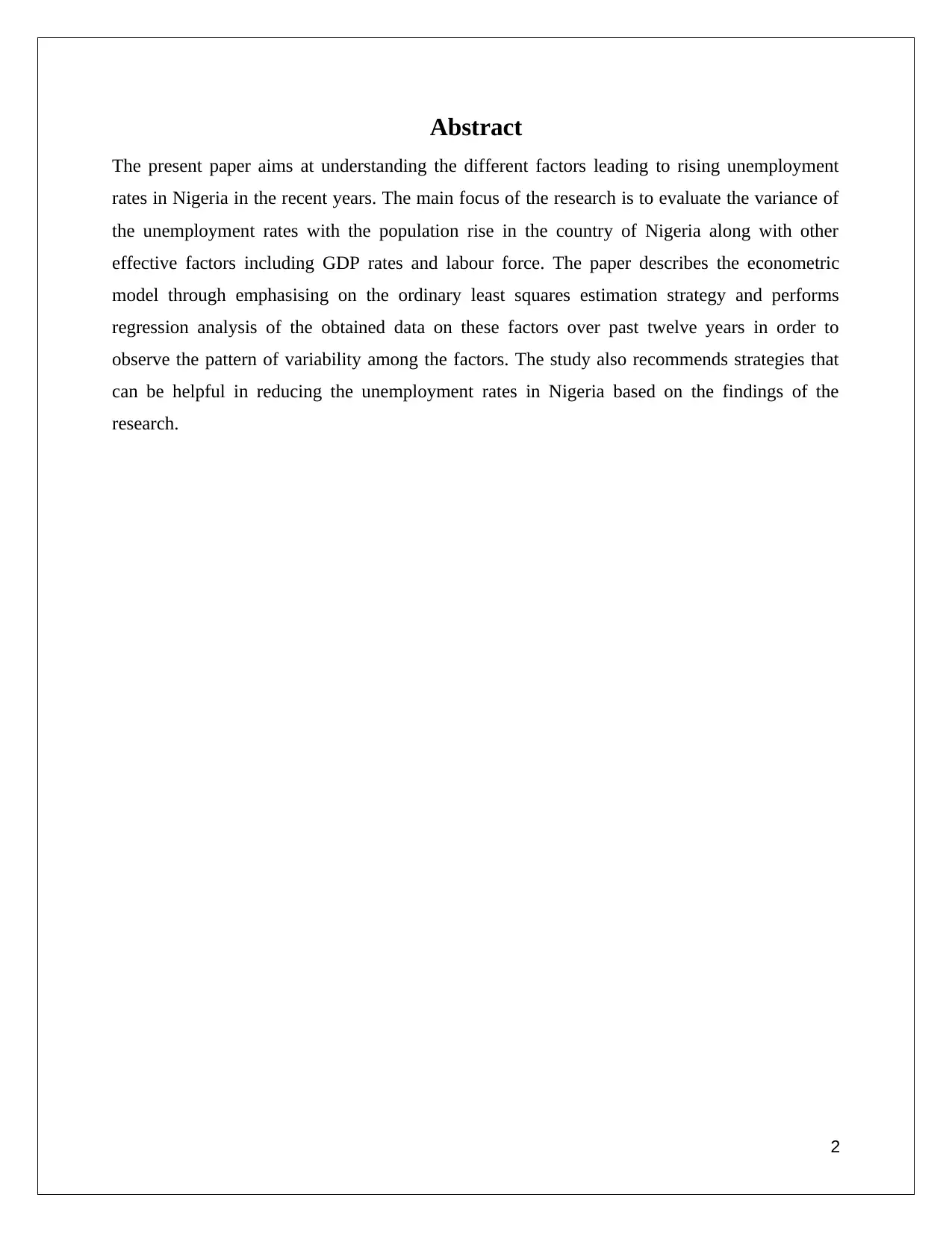
Abstract
The present paper aims at understanding the different factors leading to rising unemployment
rates in Nigeria in the recent years. The main focus of the research is to evaluate the variance of
the unemployment rates with the population rise in the country of Nigeria along with other
effective factors including GDP rates and labour force. The paper describes the econometric
model through emphasising on the ordinary least squares estimation strategy and performs
regression analysis of the obtained data on these factors over past twelve years in order to
observe the pattern of variability among the factors. The study also recommends strategies that
can be helpful in reducing the unemployment rates in Nigeria based on the findings of the
research.
2
The present paper aims at understanding the different factors leading to rising unemployment
rates in Nigeria in the recent years. The main focus of the research is to evaluate the variance of
the unemployment rates with the population rise in the country of Nigeria along with other
effective factors including GDP rates and labour force. The paper describes the econometric
model through emphasising on the ordinary least squares estimation strategy and performs
regression analysis of the obtained data on these factors over past twelve years in order to
observe the pattern of variability among the factors. The study also recommends strategies that
can be helpful in reducing the unemployment rates in Nigeria based on the findings of the
research.
2
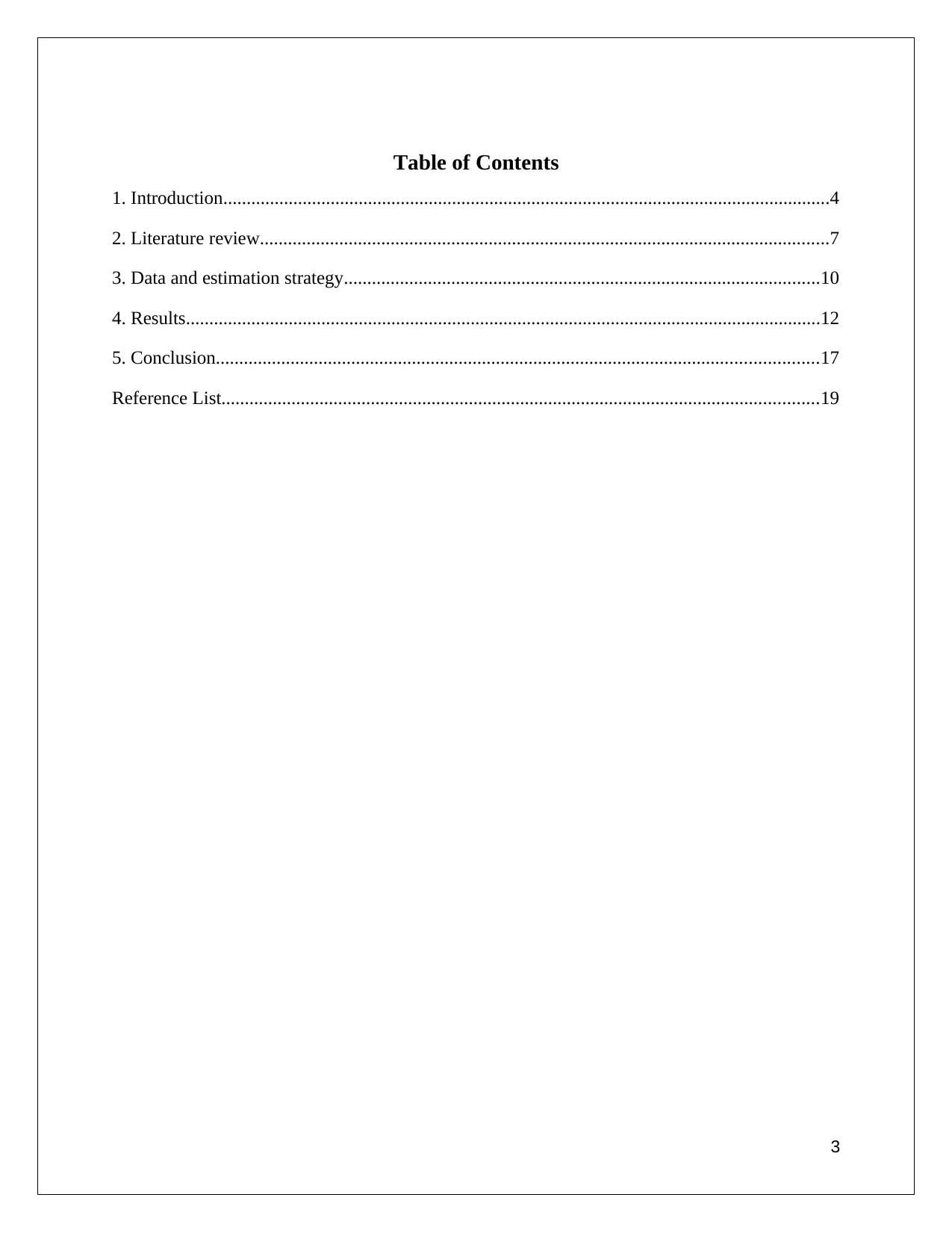
Table of Contents
1. Introduction..................................................................................................................................4
2. Literature review..........................................................................................................................7
3. Data and estimation strategy......................................................................................................10
4. Results........................................................................................................................................12
5. Conclusion.................................................................................................................................17
Reference List................................................................................................................................19
3
1. Introduction..................................................................................................................................4
2. Literature review..........................................................................................................................7
3. Data and estimation strategy......................................................................................................10
4. Results........................................................................................................................................12
5. Conclusion.................................................................................................................................17
Reference List................................................................................................................................19
3
⊘ This is a preview!⊘
Do you want full access?
Subscribe today to unlock all pages.

Trusted by 1+ million students worldwide
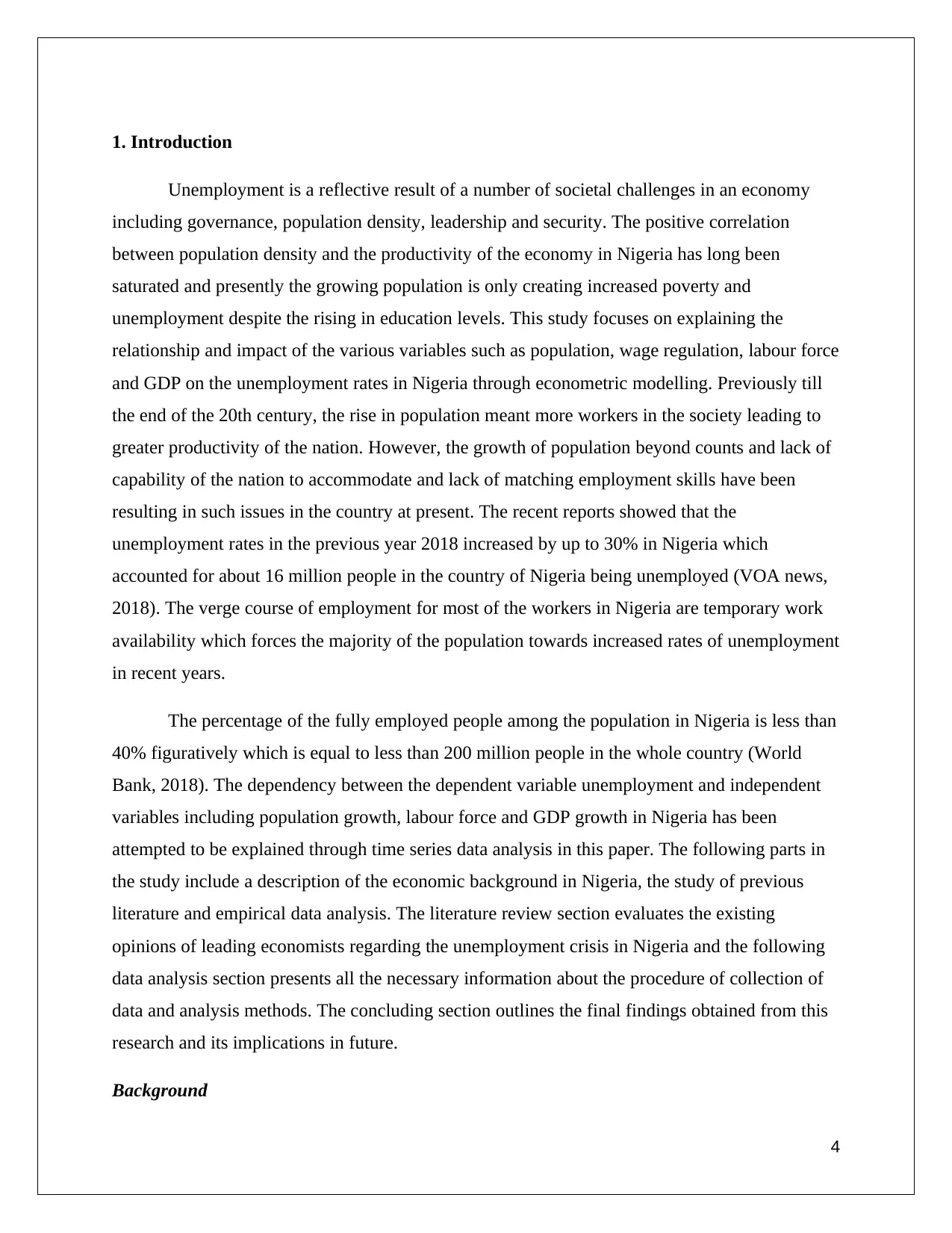
1. Introduction
Unemployment is a reflective result of a number of societal challenges in an economy
including governance, population density, leadership and security. The positive correlation
between population density and the productivity of the economy in Nigeria has long been
saturated and presently the growing population is only creating increased poverty and
unemployment despite the rising in education levels. This study focuses on explaining the
relationship and impact of the various variables such as population, wage regulation, labour force
and GDP on the unemployment rates in Nigeria through econometric modelling. Previously till
the end of the 20th century, the rise in population meant more workers in the society leading to
greater productivity of the nation. However, the growth of population beyond counts and lack of
capability of the nation to accommodate and lack of matching employment skills have been
resulting in such issues in the country at present. The recent reports showed that the
unemployment rates in the previous year 2018 increased by up to 30% in Nigeria which
accounted for about 16 million people in the country of Nigeria being unemployed (VOA news,
2018). The verge course of employment for most of the workers in Nigeria are temporary work
availability which forces the majority of the population towards increased rates of unemployment
in recent years.
The percentage of the fully employed people among the population in Nigeria is less than
40% figuratively which is equal to less than 200 million people in the whole country (World
Bank, 2018). The dependency between the dependent variable unemployment and independent
variables including population growth, labour force and GDP growth in Nigeria has been
attempted to be explained through time series data analysis in this paper. The following parts in
the study include a description of the economic background in Nigeria, the study of previous
literature and empirical data analysis. The literature review section evaluates the existing
opinions of leading economists regarding the unemployment crisis in Nigeria and the following
data analysis section presents all the necessary information about the procedure of collection of
data and analysis methods. The concluding section outlines the final findings obtained from this
research and its implications in future.
Background
4
Unemployment is a reflective result of a number of societal challenges in an economy
including governance, population density, leadership and security. The positive correlation
between population density and the productivity of the economy in Nigeria has long been
saturated and presently the growing population is only creating increased poverty and
unemployment despite the rising in education levels. This study focuses on explaining the
relationship and impact of the various variables such as population, wage regulation, labour force
and GDP on the unemployment rates in Nigeria through econometric modelling. Previously till
the end of the 20th century, the rise in population meant more workers in the society leading to
greater productivity of the nation. However, the growth of population beyond counts and lack of
capability of the nation to accommodate and lack of matching employment skills have been
resulting in such issues in the country at present. The recent reports showed that the
unemployment rates in the previous year 2018 increased by up to 30% in Nigeria which
accounted for about 16 million people in the country of Nigeria being unemployed (VOA news,
2018). The verge course of employment for most of the workers in Nigeria are temporary work
availability which forces the majority of the population towards increased rates of unemployment
in recent years.
The percentage of the fully employed people among the population in Nigeria is less than
40% figuratively which is equal to less than 200 million people in the whole country (World
Bank, 2018). The dependency between the dependent variable unemployment and independent
variables including population growth, labour force and GDP growth in Nigeria has been
attempted to be explained through time series data analysis in this paper. The following parts in
the study include a description of the economic background in Nigeria, the study of previous
literature and empirical data analysis. The literature review section evaluates the existing
opinions of leading economists regarding the unemployment crisis in Nigeria and the following
data analysis section presents all the necessary information about the procedure of collection of
data and analysis methods. The concluding section outlines the final findings obtained from this
research and its implications in future.
Background
4
Paraphrase This Document
Need a fresh take? Get an instant paraphrase of this document with our AI Paraphraser
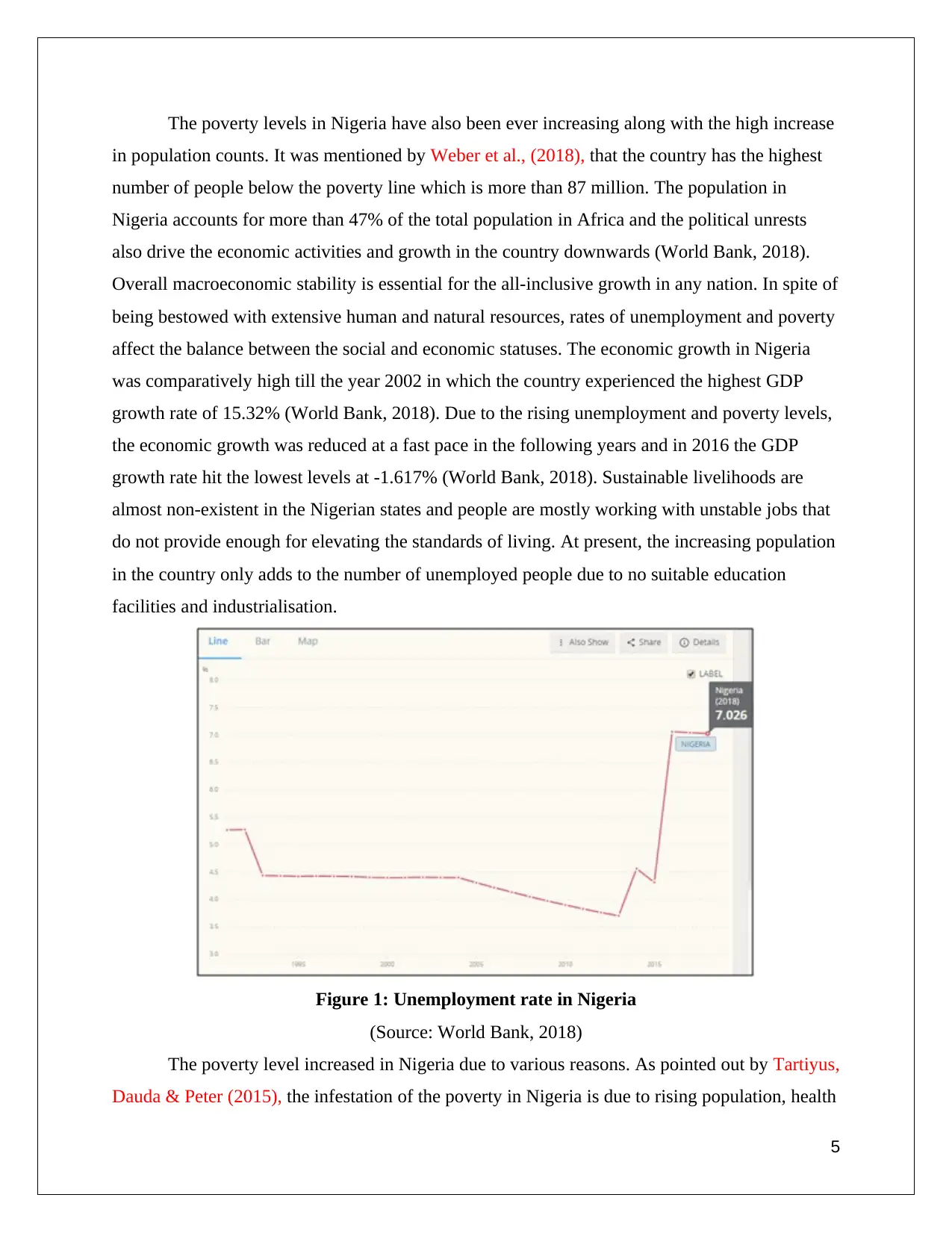
The poverty levels in Nigeria have also been ever increasing along with the high increase
in population counts. It was mentioned by Weber et al., (2018), that the country has the highest
number of people below the poverty line which is more than 87 million. The population in
Nigeria accounts for more than 47% of the total population in Africa and the political unrests
also drive the economic activities and growth in the country downwards (World Bank, 2018).
Overall macroeconomic stability is essential for the all-inclusive growth in any nation. In spite of
being bestowed with extensive human and natural resources, rates of unemployment and poverty
affect the balance between the social and economic statuses. The economic growth in Nigeria
was comparatively high till the year 2002 in which the country experienced the highest GDP
growth rate of 15.32% (World Bank, 2018). Due to the rising unemployment and poverty levels,
the economic growth was reduced at a fast pace in the following years and in 2016 the GDP
growth rate hit the lowest levels at -1.617% (World Bank, 2018). Sustainable livelihoods are
almost non-existent in the Nigerian states and people are mostly working with unstable jobs that
do not provide enough for elevating the standards of living. At present, the increasing population
in the country only adds to the number of unemployed people due to no suitable education
facilities and industrialisation.
Figure 1: Unemployment rate in Nigeria
(Source: World Bank, 2018)
The poverty level increased in Nigeria due to various reasons. As pointed out by Tartiyus,
Dauda & Peter (2015), the infestation of the poverty in Nigeria is due to rising population, health
5
in population counts. It was mentioned by Weber et al., (2018), that the country has the highest
number of people below the poverty line which is more than 87 million. The population in
Nigeria accounts for more than 47% of the total population in Africa and the political unrests
also drive the economic activities and growth in the country downwards (World Bank, 2018).
Overall macroeconomic stability is essential for the all-inclusive growth in any nation. In spite of
being bestowed with extensive human and natural resources, rates of unemployment and poverty
affect the balance between the social and economic statuses. The economic growth in Nigeria
was comparatively high till the year 2002 in which the country experienced the highest GDP
growth rate of 15.32% (World Bank, 2018). Due to the rising unemployment and poverty levels,
the economic growth was reduced at a fast pace in the following years and in 2016 the GDP
growth rate hit the lowest levels at -1.617% (World Bank, 2018). Sustainable livelihoods are
almost non-existent in the Nigerian states and people are mostly working with unstable jobs that
do not provide enough for elevating the standards of living. At present, the increasing population
in the country only adds to the number of unemployed people due to no suitable education
facilities and industrialisation.
Figure 1: Unemployment rate in Nigeria
(Source: World Bank, 2018)
The poverty level increased in Nigeria due to various reasons. As pointed out by Tartiyus,
Dauda & Peter (2015), the infestation of the poverty in Nigeria is due to rising population, health
5
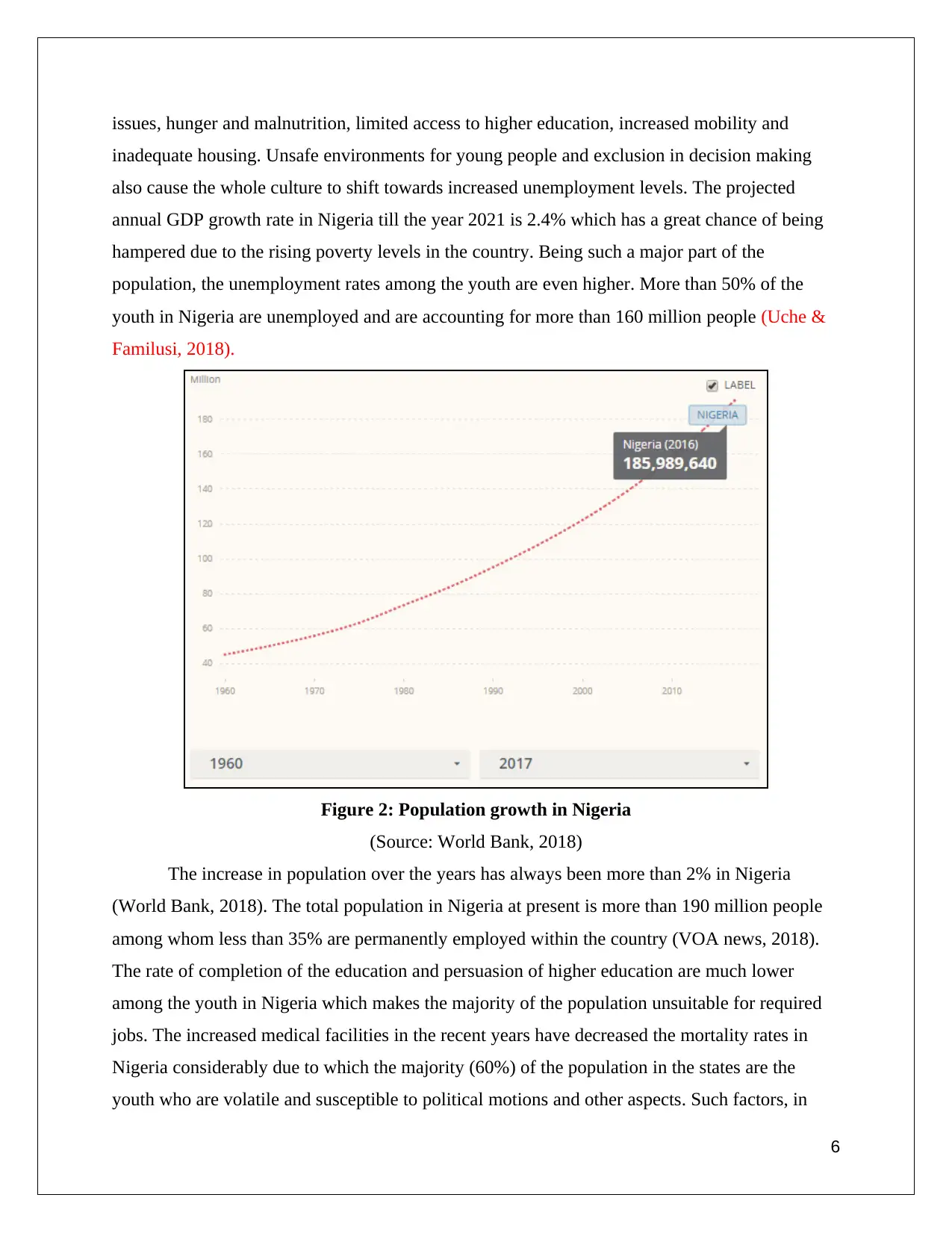
issues, hunger and malnutrition, limited access to higher education, increased mobility and
inadequate housing. Unsafe environments for young people and exclusion in decision making
also cause the whole culture to shift towards increased unemployment levels. The projected
annual GDP growth rate in Nigeria till the year 2021 is 2.4% which has a great chance of being
hampered due to the rising poverty levels in the country. Being such a major part of the
population, the unemployment rates among the youth are even higher. More than 50% of the
youth in Nigeria are unemployed and are accounting for more than 160 million people (Uche &
Familusi, 2018).
Figure 2: Population growth in Nigeria
(Source: World Bank, 2018)
The increase in population over the years has always been more than 2% in Nigeria
(World Bank, 2018). The total population in Nigeria at present is more than 190 million people
among whom less than 35% are permanently employed within the country (VOA news, 2018).
The rate of completion of the education and persuasion of higher education are much lower
among the youth in Nigeria which makes the majority of the population unsuitable for required
jobs. The increased medical facilities in the recent years have decreased the mortality rates in
Nigeria considerably due to which the majority (60%) of the population in the states are the
youth who are volatile and susceptible to political motions and other aspects. Such factors, in
6
inadequate housing. Unsafe environments for young people and exclusion in decision making
also cause the whole culture to shift towards increased unemployment levels. The projected
annual GDP growth rate in Nigeria till the year 2021 is 2.4% which has a great chance of being
hampered due to the rising poverty levels in the country. Being such a major part of the
population, the unemployment rates among the youth are even higher. More than 50% of the
youth in Nigeria are unemployed and are accounting for more than 160 million people (Uche &
Familusi, 2018).
Figure 2: Population growth in Nigeria
(Source: World Bank, 2018)
The increase in population over the years has always been more than 2% in Nigeria
(World Bank, 2018). The total population in Nigeria at present is more than 190 million people
among whom less than 35% are permanently employed within the country (VOA news, 2018).
The rate of completion of the education and persuasion of higher education are much lower
among the youth in Nigeria which makes the majority of the population unsuitable for required
jobs. The increased medical facilities in the recent years have decreased the mortality rates in
Nigeria considerably due to which the majority (60%) of the population in the states are the
youth who are volatile and susceptible to political motions and other aspects. Such factors, in
6
⊘ This is a preview!⊘
Do you want full access?
Subscribe today to unlock all pages.

Trusted by 1+ million students worldwide
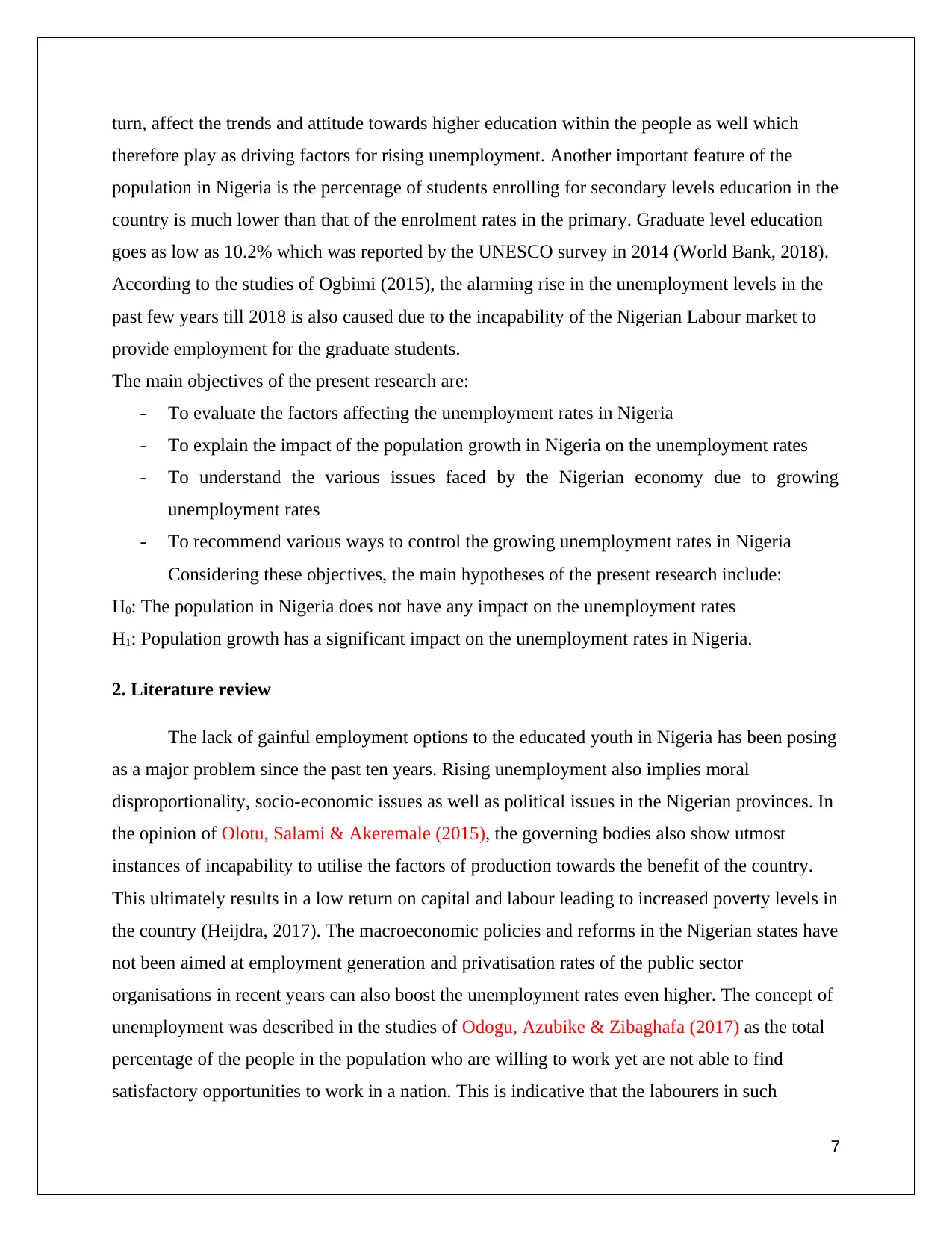
turn, affect the trends and attitude towards higher education within the people as well which
therefore play as driving factors for rising unemployment. Another important feature of the
population in Nigeria is the percentage of students enrolling for secondary levels education in the
country is much lower than that of the enrolment rates in the primary. Graduate level education
goes as low as 10.2% which was reported by the UNESCO survey in 2014 (World Bank, 2018).
According to the studies of Ogbimi (2015), the alarming rise in the unemployment levels in the
past few years till 2018 is also caused due to the incapability of the Nigerian Labour market to
provide employment for the graduate students.
The main objectives of the present research are:
- To evaluate the factors affecting the unemployment rates in Nigeria
- To explain the impact of the population growth in Nigeria on the unemployment rates
- To understand the various issues faced by the Nigerian economy due to growing
unemployment rates
- To recommend various ways to control the growing unemployment rates in Nigeria
Considering these objectives, the main hypotheses of the present research include:
H0: The population in Nigeria does not have any impact on the unemployment rates
H1: Population growth has a significant impact on the unemployment rates in Nigeria.
2. Literature review
The lack of gainful employment options to the educated youth in Nigeria has been posing
as a major problem since the past ten years. Rising unemployment also implies moral
disproportionality, socio-economic issues as well as political issues in the Nigerian provinces. In
the opinion of Olotu, Salami & Akeremale (2015), the governing bodies also show utmost
instances of incapability to utilise the factors of production towards the benefit of the country.
This ultimately results in a low return on capital and labour leading to increased poverty levels in
the country (Heijdra, 2017). The macroeconomic policies and reforms in the Nigerian states have
not been aimed at employment generation and privatisation rates of the public sector
organisations in recent years can also boost the unemployment rates even higher. The concept of
unemployment was described in the studies of Odogu, Azubike & Zibaghafa (2017) as the total
percentage of the people in the population who are willing to work yet are not able to find
satisfactory opportunities to work in a nation. This is indicative that the labourers in such
7
therefore play as driving factors for rising unemployment. Another important feature of the
population in Nigeria is the percentage of students enrolling for secondary levels education in the
country is much lower than that of the enrolment rates in the primary. Graduate level education
goes as low as 10.2% which was reported by the UNESCO survey in 2014 (World Bank, 2018).
According to the studies of Ogbimi (2015), the alarming rise in the unemployment levels in the
past few years till 2018 is also caused due to the incapability of the Nigerian Labour market to
provide employment for the graduate students.
The main objectives of the present research are:
- To evaluate the factors affecting the unemployment rates in Nigeria
- To explain the impact of the population growth in Nigeria on the unemployment rates
- To understand the various issues faced by the Nigerian economy due to growing
unemployment rates
- To recommend various ways to control the growing unemployment rates in Nigeria
Considering these objectives, the main hypotheses of the present research include:
H0: The population in Nigeria does not have any impact on the unemployment rates
H1: Population growth has a significant impact on the unemployment rates in Nigeria.
2. Literature review
The lack of gainful employment options to the educated youth in Nigeria has been posing
as a major problem since the past ten years. Rising unemployment also implies moral
disproportionality, socio-economic issues as well as political issues in the Nigerian provinces. In
the opinion of Olotu, Salami & Akeremale (2015), the governing bodies also show utmost
instances of incapability to utilise the factors of production towards the benefit of the country.
This ultimately results in a low return on capital and labour leading to increased poverty levels in
the country (Heijdra, 2017). The macroeconomic policies and reforms in the Nigerian states have
not been aimed at employment generation and privatisation rates of the public sector
organisations in recent years can also boost the unemployment rates even higher. The concept of
unemployment was described in the studies of Odogu, Azubike & Zibaghafa (2017) as the total
percentage of the people in the population who are willing to work yet are not able to find
satisfactory opportunities to work in a nation. This is indicative that the labourers in such
7
Paraphrase This Document
Need a fresh take? Get an instant paraphrase of this document with our AI Paraphraser
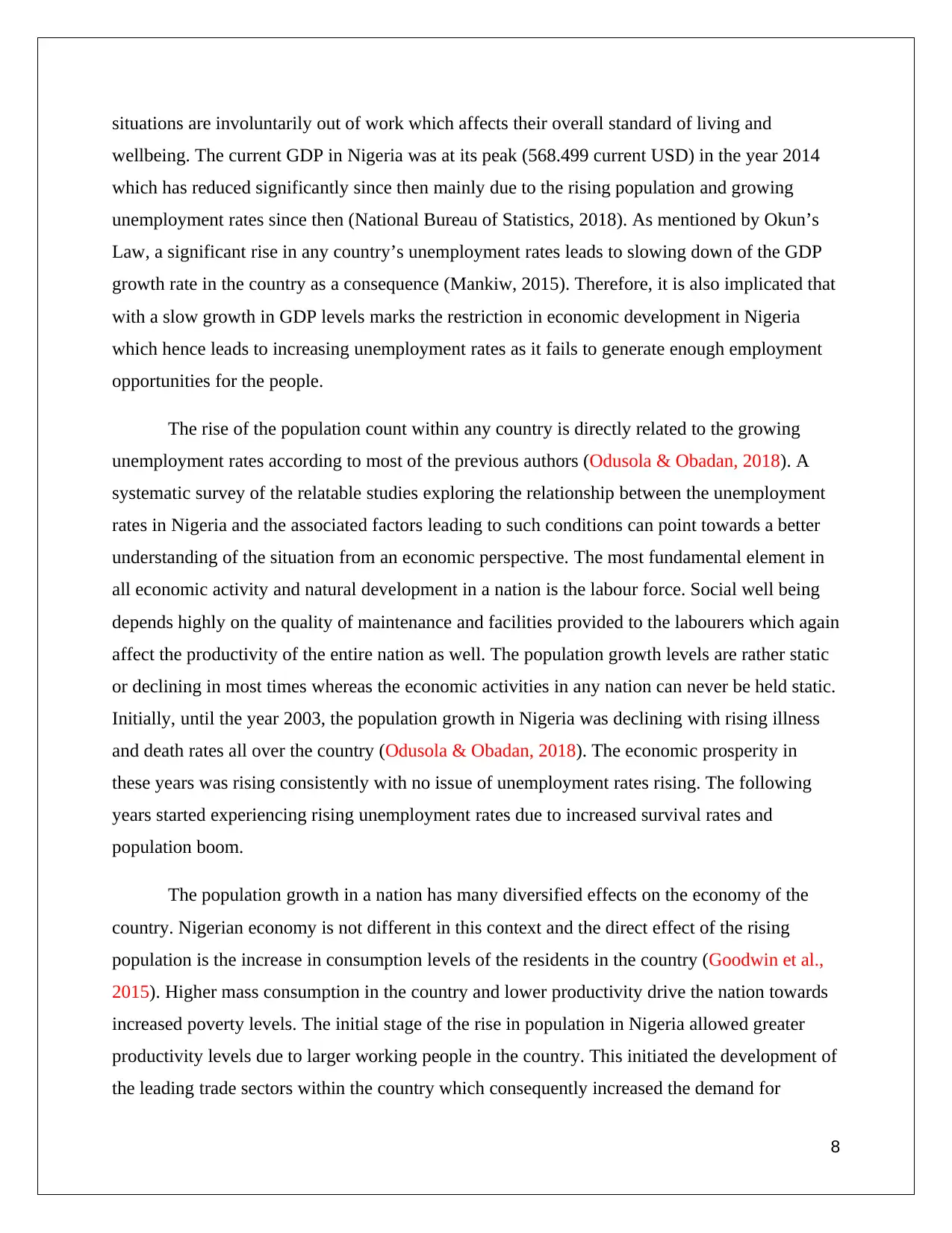
situations are involuntarily out of work which affects their overall standard of living and
wellbeing. The current GDP in Nigeria was at its peak (568.499 current USD) in the year 2014
which has reduced significantly since then mainly due to the rising population and growing
unemployment rates since then (National Bureau of Statistics, 2018). As mentioned by Okun’s
Law, a significant rise in any country’s unemployment rates leads to slowing down of the GDP
growth rate in the country as a consequence (Mankiw, 2015). Therefore, it is also implicated that
with a slow growth in GDP levels marks the restriction in economic development in Nigeria
which hence leads to increasing unemployment rates as it fails to generate enough employment
opportunities for the people.
The rise of the population count within any country is directly related to the growing
unemployment rates according to most of the previous authors (Odusola & Obadan, 2018). A
systematic survey of the relatable studies exploring the relationship between the unemployment
rates in Nigeria and the associated factors leading to such conditions can point towards a better
understanding of the situation from an economic perspective. The most fundamental element in
all economic activity and natural development in a nation is the labour force. Social well being
depends highly on the quality of maintenance and facilities provided to the labourers which again
affect the productivity of the entire nation as well. The population growth levels are rather static
or declining in most times whereas the economic activities in any nation can never be held static.
Initially, until the year 2003, the population growth in Nigeria was declining with rising illness
and death rates all over the country (Odusola & Obadan, 2018). The economic prosperity in
these years was rising consistently with no issue of unemployment rates rising. The following
years started experiencing rising unemployment rates due to increased survival rates and
population boom.
The population growth in a nation has many diversified effects on the economy of the
country. Nigerian economy is not different in this context and the direct effect of the rising
population is the increase in consumption levels of the residents in the country (Goodwin et al.,
2015). Higher mass consumption in the country and lower productivity drive the nation towards
increased poverty levels. The initial stage of the rise in population in Nigeria allowed greater
productivity levels due to larger working people in the country. This initiated the development of
the leading trade sectors within the country which consequently increased the demand for
8
wellbeing. The current GDP in Nigeria was at its peak (568.499 current USD) in the year 2014
which has reduced significantly since then mainly due to the rising population and growing
unemployment rates since then (National Bureau of Statistics, 2018). As mentioned by Okun’s
Law, a significant rise in any country’s unemployment rates leads to slowing down of the GDP
growth rate in the country as a consequence (Mankiw, 2015). Therefore, it is also implicated that
with a slow growth in GDP levels marks the restriction in economic development in Nigeria
which hence leads to increasing unemployment rates as it fails to generate enough employment
opportunities for the people.
The rise of the population count within any country is directly related to the growing
unemployment rates according to most of the previous authors (Odusola & Obadan, 2018). A
systematic survey of the relatable studies exploring the relationship between the unemployment
rates in Nigeria and the associated factors leading to such conditions can point towards a better
understanding of the situation from an economic perspective. The most fundamental element in
all economic activity and natural development in a nation is the labour force. Social well being
depends highly on the quality of maintenance and facilities provided to the labourers which again
affect the productivity of the entire nation as well. The population growth levels are rather static
or declining in most times whereas the economic activities in any nation can never be held static.
Initially, until the year 2003, the population growth in Nigeria was declining with rising illness
and death rates all over the country (Odusola & Obadan, 2018). The economic prosperity in
these years was rising consistently with no issue of unemployment rates rising. The following
years started experiencing rising unemployment rates due to increased survival rates and
population boom.
The population growth in a nation has many diversified effects on the economy of the
country. Nigerian economy is not different in this context and the direct effect of the rising
population is the increase in consumption levels of the residents in the country (Goodwin et al.,
2015). Higher mass consumption in the country and lower productivity drive the nation towards
increased poverty levels. The initial stage of the rise in population in Nigeria allowed greater
productivity levels due to larger working people in the country. This initiated the development of
the leading trade sectors within the country which consequently increased the demand for
8
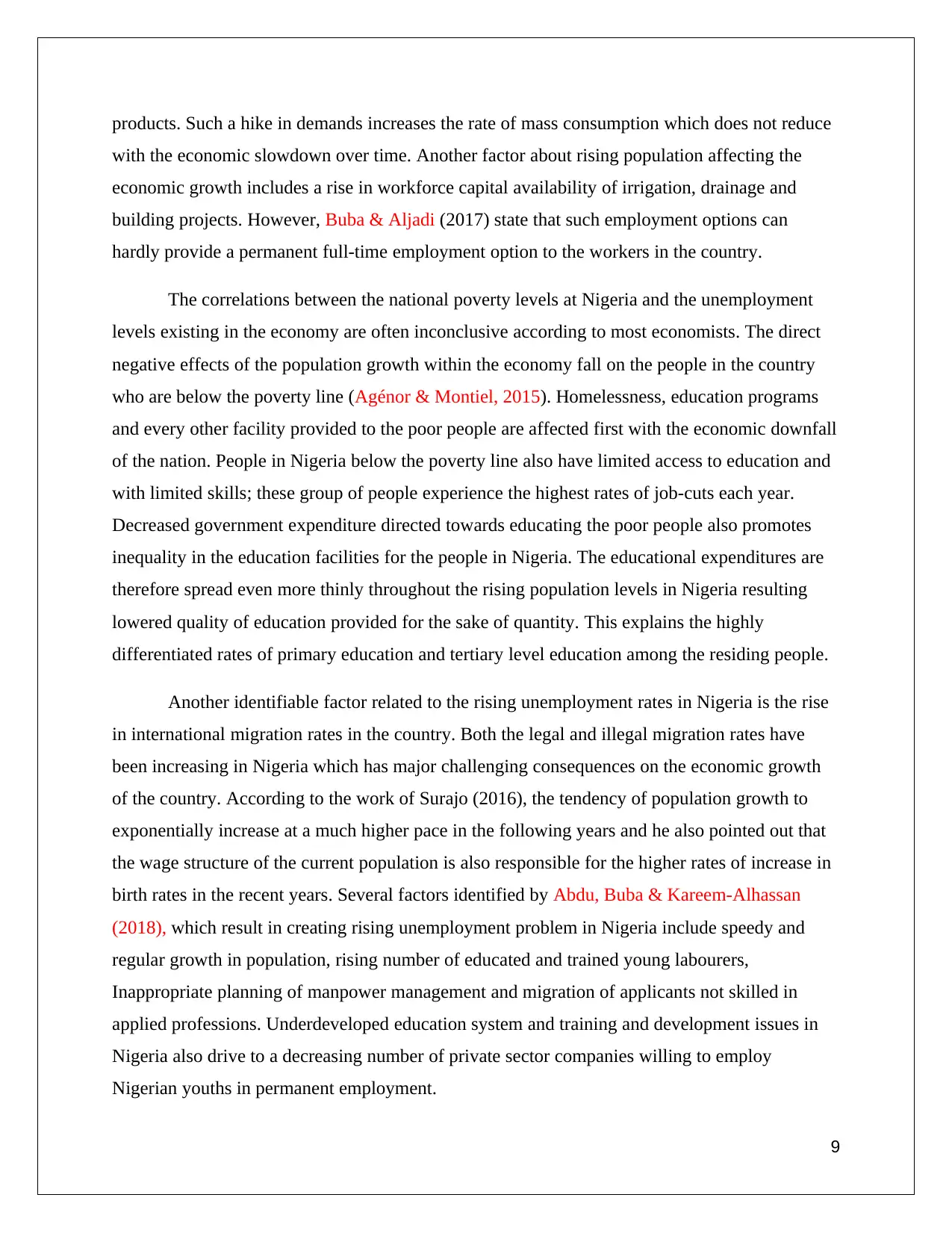
products. Such a hike in demands increases the rate of mass consumption which does not reduce
with the economic slowdown over time. Another factor about rising population affecting the
economic growth includes a rise in workforce capital availability of irrigation, drainage and
building projects. However, Buba & Aljadi (2017) state that such employment options can
hardly provide a permanent full-time employment option to the workers in the country.
The correlations between the national poverty levels at Nigeria and the unemployment
levels existing in the economy are often inconclusive according to most economists. The direct
negative effects of the population growth within the economy fall on the people in the country
who are below the poverty line (Agénor & Montiel, 2015). Homelessness, education programs
and every other facility provided to the poor people are affected first with the economic downfall
of the nation. People in Nigeria below the poverty line also have limited access to education and
with limited skills; these group of people experience the highest rates of job-cuts each year.
Decreased government expenditure directed towards educating the poor people also promotes
inequality in the education facilities for the people in Nigeria. The educational expenditures are
therefore spread even more thinly throughout the rising population levels in Nigeria resulting
lowered quality of education provided for the sake of quantity. This explains the highly
differentiated rates of primary education and tertiary level education among the residing people.
Another identifiable factor related to the rising unemployment rates in Nigeria is the rise
in international migration rates in the country. Both the legal and illegal migration rates have
been increasing in Nigeria which has major challenging consequences on the economic growth
of the country. According to the work of Surajo (2016), the tendency of population growth to
exponentially increase at a much higher pace in the following years and he also pointed out that
the wage structure of the current population is also responsible for the higher rates of increase in
birth rates in the recent years. Several factors identified by Abdu, Buba & Kareem-Alhassan
(2018), which result in creating rising unemployment problem in Nigeria include speedy and
regular growth in population, rising number of educated and trained young labourers,
Inappropriate planning of manpower management and migration of applicants not skilled in
applied professions. Underdeveloped education system and training and development issues in
Nigeria also drive to a decreasing number of private sector companies willing to employ
Nigerian youths in permanent employment.
9
with the economic slowdown over time. Another factor about rising population affecting the
economic growth includes a rise in workforce capital availability of irrigation, drainage and
building projects. However, Buba & Aljadi (2017) state that such employment options can
hardly provide a permanent full-time employment option to the workers in the country.
The correlations between the national poverty levels at Nigeria and the unemployment
levels existing in the economy are often inconclusive according to most economists. The direct
negative effects of the population growth within the economy fall on the people in the country
who are below the poverty line (Agénor & Montiel, 2015). Homelessness, education programs
and every other facility provided to the poor people are affected first with the economic downfall
of the nation. People in Nigeria below the poverty line also have limited access to education and
with limited skills; these group of people experience the highest rates of job-cuts each year.
Decreased government expenditure directed towards educating the poor people also promotes
inequality in the education facilities for the people in Nigeria. The educational expenditures are
therefore spread even more thinly throughout the rising population levels in Nigeria resulting
lowered quality of education provided for the sake of quantity. This explains the highly
differentiated rates of primary education and tertiary level education among the residing people.
Another identifiable factor related to the rising unemployment rates in Nigeria is the rise
in international migration rates in the country. Both the legal and illegal migration rates have
been increasing in Nigeria which has major challenging consequences on the economic growth
of the country. According to the work of Surajo (2016), the tendency of population growth to
exponentially increase at a much higher pace in the following years and he also pointed out that
the wage structure of the current population is also responsible for the higher rates of increase in
birth rates in the recent years. Several factors identified by Abdu, Buba & Kareem-Alhassan
(2018), which result in creating rising unemployment problem in Nigeria include speedy and
regular growth in population, rising number of educated and trained young labourers,
Inappropriate planning of manpower management and migration of applicants not skilled in
applied professions. Underdeveloped education system and training and development issues in
Nigeria also drive to a decreasing number of private sector companies willing to employ
Nigerian youths in permanent employment.
9
⊘ This is a preview!⊘
Do you want full access?
Subscribe today to unlock all pages.

Trusted by 1+ million students worldwide
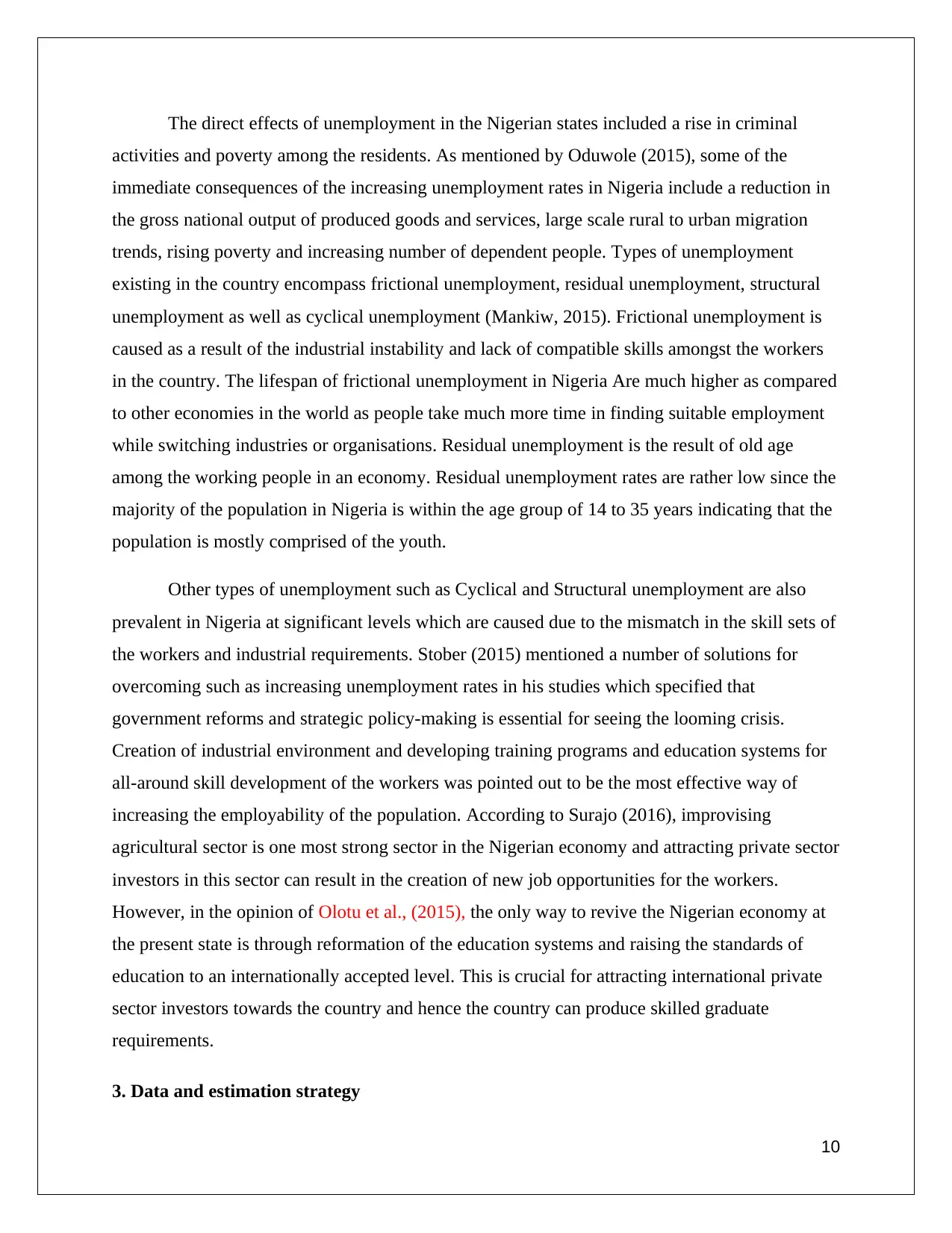
The direct effects of unemployment in the Nigerian states included a rise in criminal
activities and poverty among the residents. As mentioned by Oduwole (2015), some of the
immediate consequences of the increasing unemployment rates in Nigeria include a reduction in
the gross national output of produced goods and services, large scale rural to urban migration
trends, rising poverty and increasing number of dependent people. Types of unemployment
existing in the country encompass frictional unemployment, residual unemployment, structural
unemployment as well as cyclical unemployment (Mankiw, 2015). Frictional unemployment is
caused as a result of the industrial instability and lack of compatible skills amongst the workers
in the country. The lifespan of frictional unemployment in Nigeria Are much higher as compared
to other economies in the world as people take much more time in finding suitable employment
while switching industries or organisations. Residual unemployment is the result of old age
among the working people in an economy. Residual unemployment rates are rather low since the
majority of the population in Nigeria is within the age group of 14 to 35 years indicating that the
population is mostly comprised of the youth.
Other types of unemployment such as Cyclical and Structural unemployment are also
prevalent in Nigeria at significant levels which are caused due to the mismatch in the skill sets of
the workers and industrial requirements. Stober (2015) mentioned a number of solutions for
overcoming such as increasing unemployment rates in his studies which specified that
government reforms and strategic policy-making is essential for seeing the looming crisis.
Creation of industrial environment and developing training programs and education systems for
all-around skill development of the workers was pointed out to be the most effective way of
increasing the employability of the population. According to Surajo (2016), improvising
agricultural sector is one most strong sector in the Nigerian economy and attracting private sector
investors in this sector can result in the creation of new job opportunities for the workers.
However, in the opinion of Olotu et al., (2015), the only way to revive the Nigerian economy at
the present state is through reformation of the education systems and raising the standards of
education to an internationally accepted level. This is crucial for attracting international private
sector investors towards the country and hence the country can produce skilled graduate
requirements.
3. Data and estimation strategy
10
activities and poverty among the residents. As mentioned by Oduwole (2015), some of the
immediate consequences of the increasing unemployment rates in Nigeria include a reduction in
the gross national output of produced goods and services, large scale rural to urban migration
trends, rising poverty and increasing number of dependent people. Types of unemployment
existing in the country encompass frictional unemployment, residual unemployment, structural
unemployment as well as cyclical unemployment (Mankiw, 2015). Frictional unemployment is
caused as a result of the industrial instability and lack of compatible skills amongst the workers
in the country. The lifespan of frictional unemployment in Nigeria Are much higher as compared
to other economies in the world as people take much more time in finding suitable employment
while switching industries or organisations. Residual unemployment is the result of old age
among the working people in an economy. Residual unemployment rates are rather low since the
majority of the population in Nigeria is within the age group of 14 to 35 years indicating that the
population is mostly comprised of the youth.
Other types of unemployment such as Cyclical and Structural unemployment are also
prevalent in Nigeria at significant levels which are caused due to the mismatch in the skill sets of
the workers and industrial requirements. Stober (2015) mentioned a number of solutions for
overcoming such as increasing unemployment rates in his studies which specified that
government reforms and strategic policy-making is essential for seeing the looming crisis.
Creation of industrial environment and developing training programs and education systems for
all-around skill development of the workers was pointed out to be the most effective way of
increasing the employability of the population. According to Surajo (2016), improvising
agricultural sector is one most strong sector in the Nigerian economy and attracting private sector
investors in this sector can result in the creation of new job opportunities for the workers.
However, in the opinion of Olotu et al., (2015), the only way to revive the Nigerian economy at
the present state is through reformation of the education systems and raising the standards of
education to an internationally accepted level. This is crucial for attracting international private
sector investors towards the country and hence the country can produce skilled graduate
requirements.
3. Data and estimation strategy
10
Paraphrase This Document
Need a fresh take? Get an instant paraphrase of this document with our AI Paraphraser
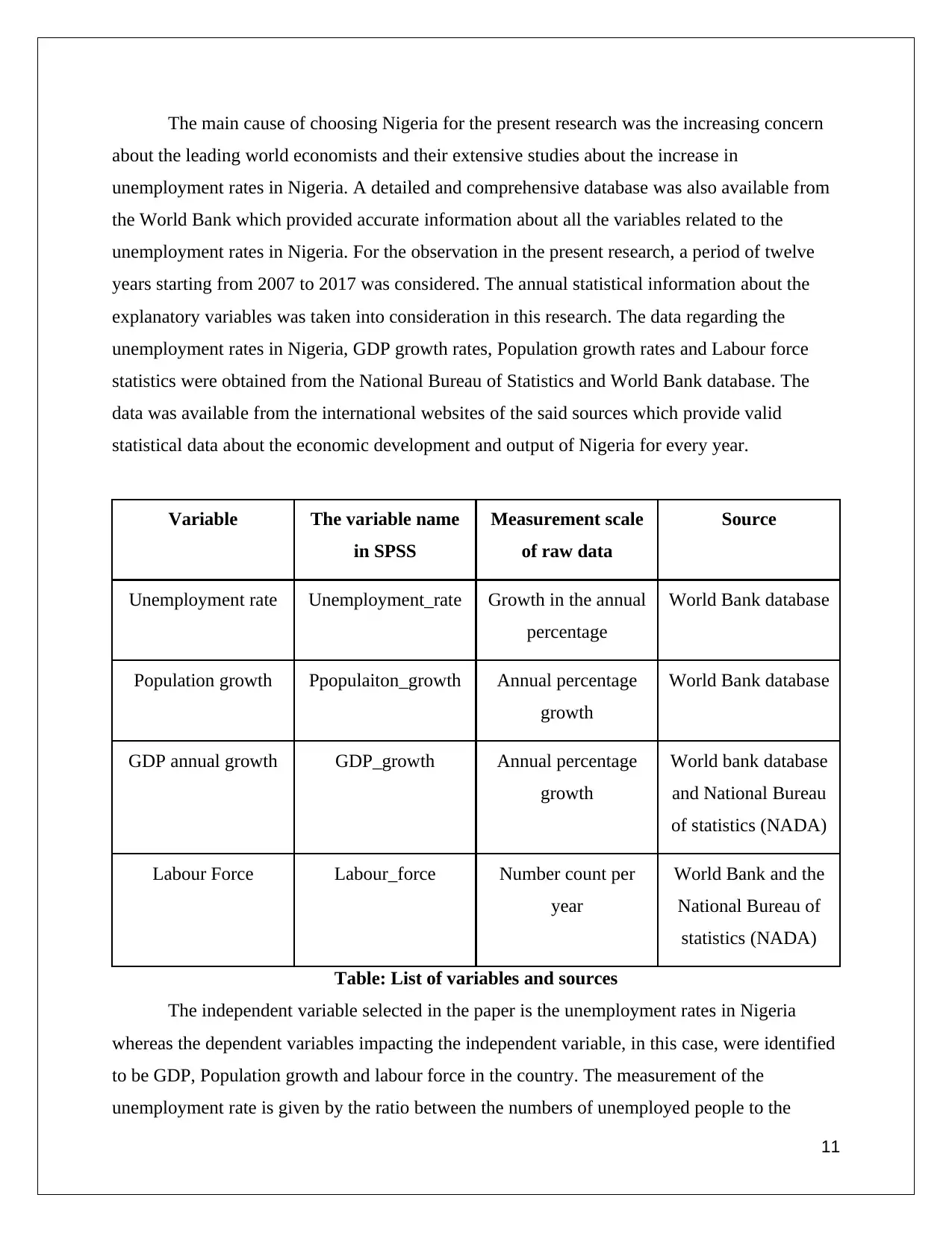
The main cause of choosing Nigeria for the present research was the increasing concern
about the leading world economists and their extensive studies about the increase in
unemployment rates in Nigeria. A detailed and comprehensive database was also available from
the World Bank which provided accurate information about all the variables related to the
unemployment rates in Nigeria. For the observation in the present research, a period of twelve
years starting from 2007 to 2017 was considered. The annual statistical information about the
explanatory variables was taken into consideration in this research. The data regarding the
unemployment rates in Nigeria, GDP growth rates, Population growth rates and Labour force
statistics were obtained from the National Bureau of Statistics and World Bank database. The
data was available from the international websites of the said sources which provide valid
statistical data about the economic development and output of Nigeria for every year.
Variable The variable name
in SPSS
Measurement scale
of raw data
Source
Unemployment rate Unemployment_rate Growth in the annual
percentage
World Bank database
Population growth Ppopulaiton_growth Annual percentage
growth
World Bank database
GDP annual growth GDP_growth Annual percentage
growth
World bank database
and National Bureau
of statistics (NADA)
Labour Force Labour_force Number count per
year
World Bank and the
National Bureau of
statistics (NADA)
Table: List of variables and sources
The independent variable selected in the paper is the unemployment rates in Nigeria
whereas the dependent variables impacting the independent variable, in this case, were identified
to be GDP, Population growth and labour force in the country. The measurement of the
unemployment rate is given by the ratio between the numbers of unemployed people to the
11
about the leading world economists and their extensive studies about the increase in
unemployment rates in Nigeria. A detailed and comprehensive database was also available from
the World Bank which provided accurate information about all the variables related to the
unemployment rates in Nigeria. For the observation in the present research, a period of twelve
years starting from 2007 to 2017 was considered. The annual statistical information about the
explanatory variables was taken into consideration in this research. The data regarding the
unemployment rates in Nigeria, GDP growth rates, Population growth rates and Labour force
statistics were obtained from the National Bureau of Statistics and World Bank database. The
data was available from the international websites of the said sources which provide valid
statistical data about the economic development and output of Nigeria for every year.
Variable The variable name
in SPSS
Measurement scale
of raw data
Source
Unemployment rate Unemployment_rate Growth in the annual
percentage
World Bank database
Population growth Ppopulaiton_growth Annual percentage
growth
World Bank database
GDP annual growth GDP_growth Annual percentage
growth
World bank database
and National Bureau
of statistics (NADA)
Labour Force Labour_force Number count per
year
World Bank and the
National Bureau of
statistics (NADA)
Table: List of variables and sources
The independent variable selected in the paper is the unemployment rates in Nigeria
whereas the dependent variables impacting the independent variable, in this case, were identified
to be GDP, Population growth and labour force in the country. The measurement of the
unemployment rate is given by the ratio between the numbers of unemployed people to the
11
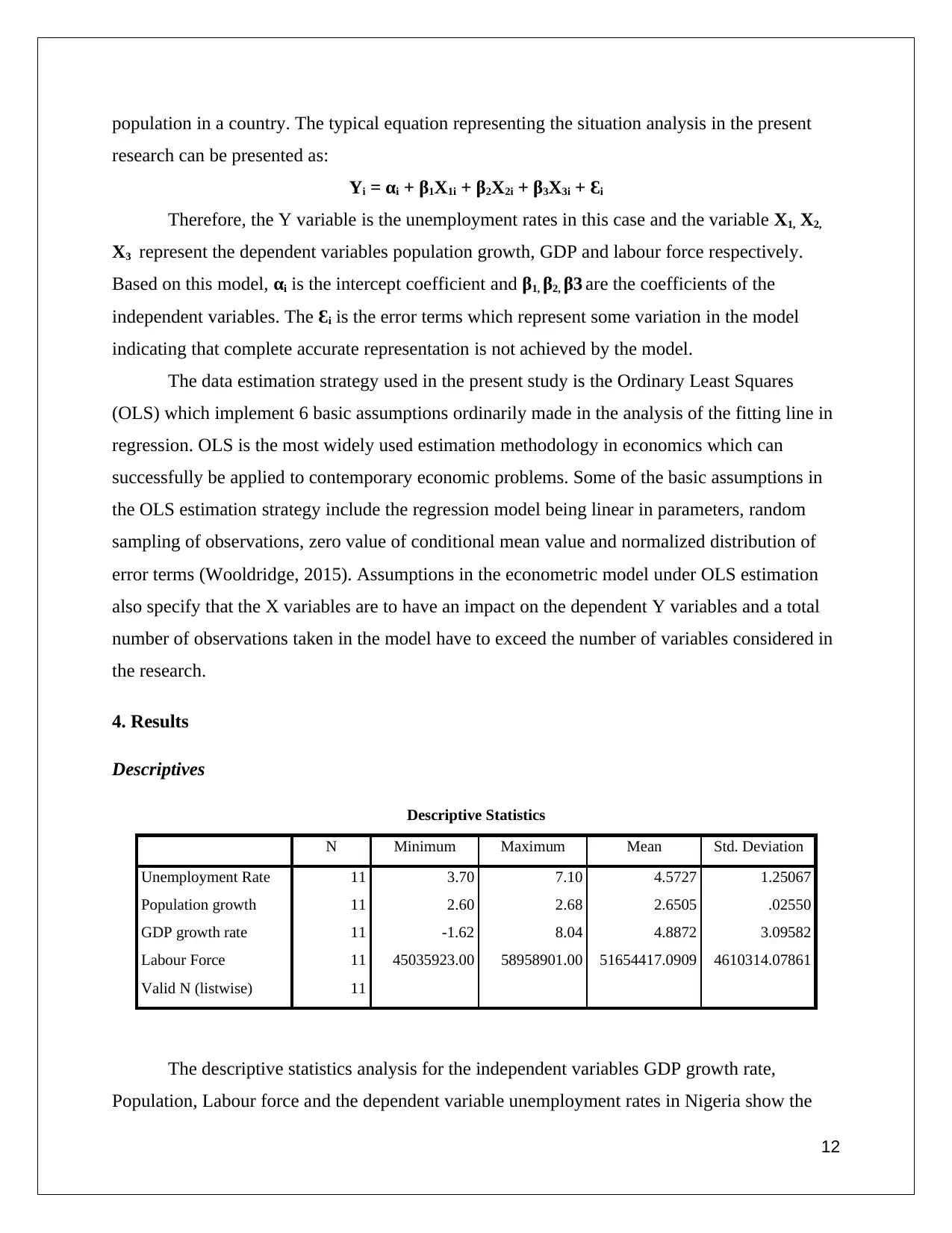
population in a country. The typical equation representing the situation analysis in the present
research can be presented as:
Yi = αi + β1X1i + β2X2i + β3X3i + Ɛi
Therefore, the Y variable is the unemployment rates in this case and the variable X1, X2,
X3 represent the dependent variables population growth, GDP and labour force respectively.
Based on this model, αi is the intercept coefficient and β1, β2, β3 are the coefficients of the
independent variables. The Ɛi is the error terms which represent some variation in the model
indicating that complete accurate representation is not achieved by the model.
The data estimation strategy used in the present study is the Ordinary Least Squares
(OLS) which implement 6 basic assumptions ordinarily made in the analysis of the fitting line in
regression. OLS is the most widely used estimation methodology in economics which can
successfully be applied to contemporary economic problems. Some of the basic assumptions in
the OLS estimation strategy include the regression model being linear in parameters, random
sampling of observations, zero value of conditional mean value and normalized distribution of
error terms (Wooldridge, 2015). Assumptions in the econometric model under OLS estimation
also specify that the X variables are to have an impact on the dependent Y variables and a total
number of observations taken in the model have to exceed the number of variables considered in
the research.
4. Results
Descriptives
Descriptive Statistics
N Minimum Maximum Mean Std. Deviation
Unemployment Rate 11 3.70 7.10 4.5727 1.25067
Population growth 11 2.60 2.68 2.6505 .02550
GDP growth rate 11 -1.62 8.04 4.8872 3.09582
Labour Force 11 45035923.00 58958901.00 51654417.0909 4610314.07861
Valid N (listwise) 11
The descriptive statistics analysis for the independent variables GDP growth rate,
Population, Labour force and the dependent variable unemployment rates in Nigeria show the
12
research can be presented as:
Yi = αi + β1X1i + β2X2i + β3X3i + Ɛi
Therefore, the Y variable is the unemployment rates in this case and the variable X1, X2,
X3 represent the dependent variables population growth, GDP and labour force respectively.
Based on this model, αi is the intercept coefficient and β1, β2, β3 are the coefficients of the
independent variables. The Ɛi is the error terms which represent some variation in the model
indicating that complete accurate representation is not achieved by the model.
The data estimation strategy used in the present study is the Ordinary Least Squares
(OLS) which implement 6 basic assumptions ordinarily made in the analysis of the fitting line in
regression. OLS is the most widely used estimation methodology in economics which can
successfully be applied to contemporary economic problems. Some of the basic assumptions in
the OLS estimation strategy include the regression model being linear in parameters, random
sampling of observations, zero value of conditional mean value and normalized distribution of
error terms (Wooldridge, 2015). Assumptions in the econometric model under OLS estimation
also specify that the X variables are to have an impact on the dependent Y variables and a total
number of observations taken in the model have to exceed the number of variables considered in
the research.
4. Results
Descriptives
Descriptive Statistics
N Minimum Maximum Mean Std. Deviation
Unemployment Rate 11 3.70 7.10 4.5727 1.25067
Population growth 11 2.60 2.68 2.6505 .02550
GDP growth rate 11 -1.62 8.04 4.8872 3.09582
Labour Force 11 45035923.00 58958901.00 51654417.0909 4610314.07861
Valid N (listwise) 11
The descriptive statistics analysis for the independent variables GDP growth rate,
Population, Labour force and the dependent variable unemployment rates in Nigeria show the
12
⊘ This is a preview!⊘
Do you want full access?
Subscribe today to unlock all pages.

Trusted by 1+ million students worldwide
1 out of 21
Related Documents
Your All-in-One AI-Powered Toolkit for Academic Success.
+13062052269
info@desklib.com
Available 24*7 on WhatsApp / Email
![[object Object]](/_next/static/media/star-bottom.7253800d.svg)
Unlock your academic potential
Copyright © 2020–2025 A2Z Services. All Rights Reserved. Developed and managed by ZUCOL.





